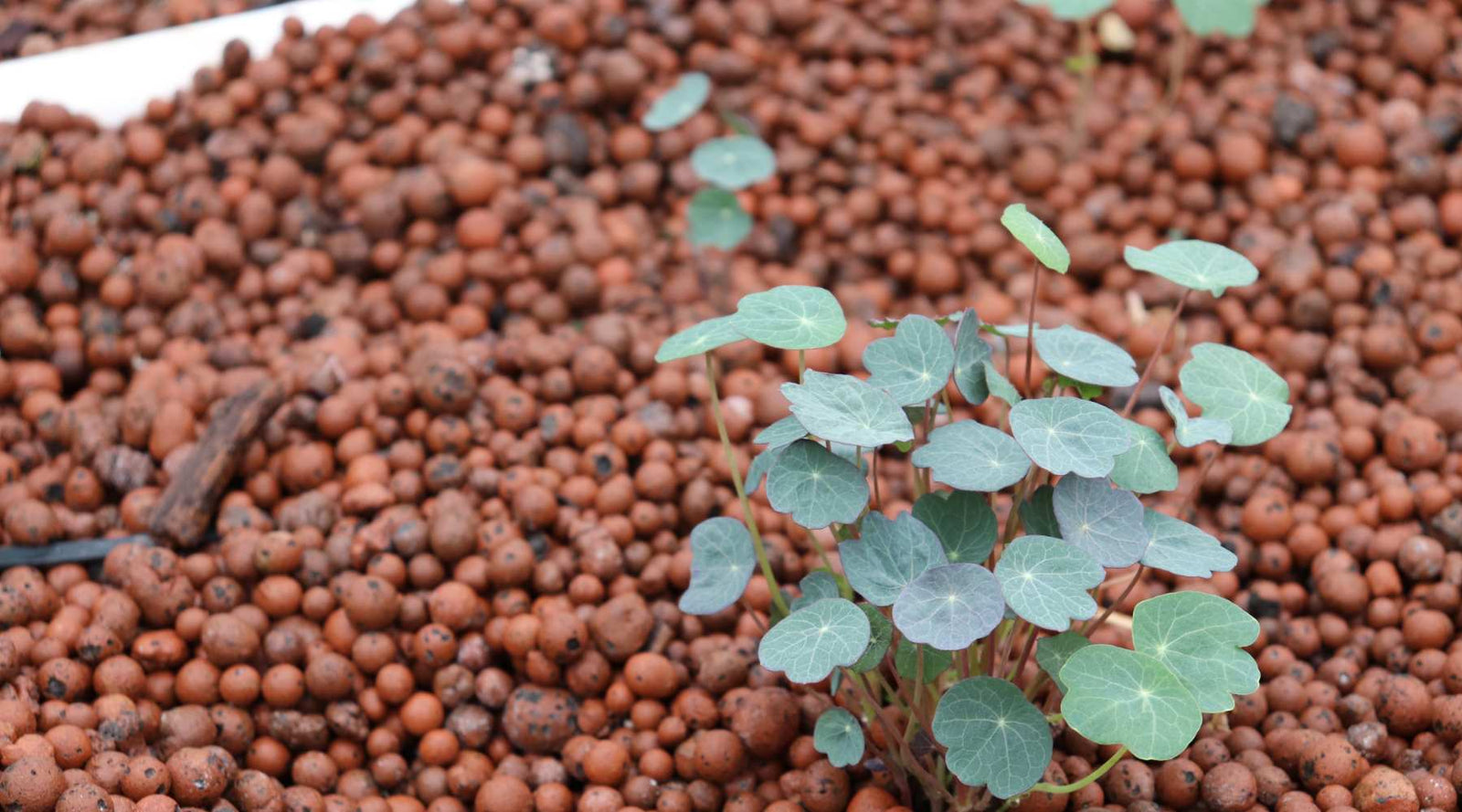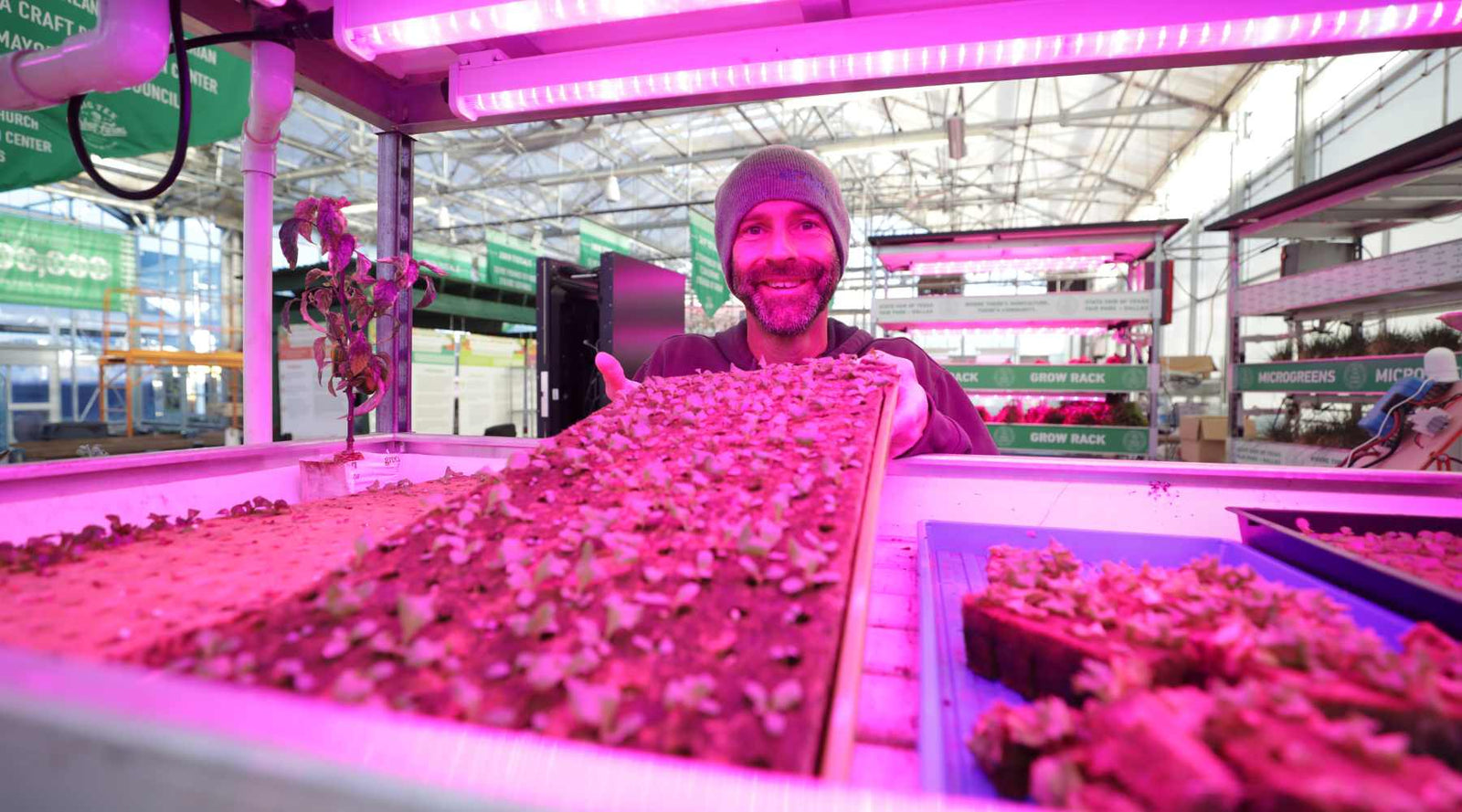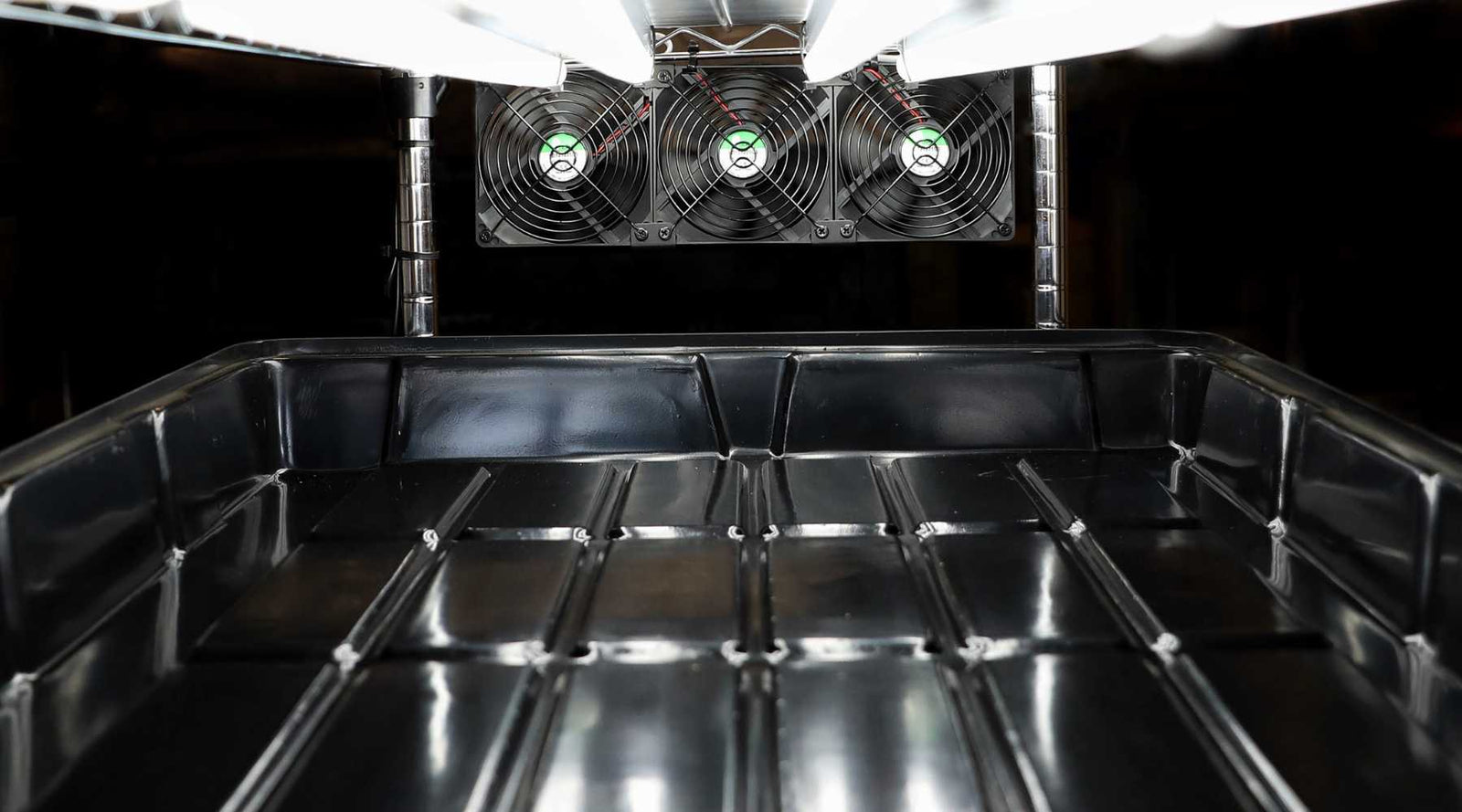Free Shipping on Orders over $75 to the Contiguous US
Free Shipping on Orders over $75 to the Contiguous US
Hydroponic Edible Flowers: How to Grow Edible Flowers Without Soil
September 02, 2025 7 min read 0 Comments

What are hydroponic edible flowers?
Many of the most popular edible flowers can be grown hydroponically. Growing edible flowers without soil in any of a number of hydroponic systems can be easier and faster than growing in soil. These include traditional flowers as well as herbs whose flowers are useful in cocktails, fine dining and cake decorating.
The following lists cover the ones most commonly grown in hydroponic systems. You can find our full list of edible flowers in this linked resource guide on Cultivating Edible Blooms.
Flowers that grow well hydroponically
- Begonias
- Butterfly Pea (Clitoria ternatea)
- Calendula
- Carnations
- Celosia
- Daylilies (Not actually a member of the lily family)
- Lavender
- Marigolds, gem varieties with small flowers as well as the larger French and African types.
- Nasturtium
- Nigella
- Rose
- Snapdragon
- Viola
- Yarrow
- Zinnia
Herbs that grow well hydroponically
- Basil
- Cilantro
- Dill
- Fennel
- Mexican Mint Marigold (AKA Southern tarragon)
- Rosemary
Benefits of growing hydroponic edible flowers
1. Easy and quick growth
Because flowers grown hydroponically do not need to expend energy in developing complex root systems for nutrient uptake, they are free to grow more leaves and flowers. The nutrient rich water in a hydroponic system allows a limited root system to uptake all of the needed ingredients for quick growth.
2. A variety of colors and sizes
When growing flowers hydroponically it is far easier to keep varieties separate and distinct. Using different heights of systems makes it simple to harvest smaller flowers from a comfortable position. It makes offering your customers a variety of sizes and colors simpler for you and adds value to your offerings.
3. No soil-based diseases
There are a myriad of plant diseases that can be passed through infected soil and sometimes carried on the seed coat. Since hydroponics uses no soil and the medium is either sterilized or replaced for each new grow there is no opportunity for those diseases to be passed on to the next crop.
4. Easier to control weeds and pests
Unless you are growing hydroponically outdoors there is little opportunity for weed seeds to become a problem in any hydroponic system. Even if a few do sneak in they are easy to identify as not belonging and even easier to remove. This reduction in weed pressure hastens growth and reduces competition for light and nutrients that can plague in ground plantings.
5. Ability to grow flowers in colder climates
Because hydroponics can be done indoors, inside hoop houses or greenhouses it allows you to grow flowers well beyond the seasons that they would grow well outdoors in your area. Flowers grown hydroponically also take up far less space than their counterparts grown in soil which means you can fit more flowers per row foot inside your hoop house.
6. Higher yields and quality
The controlled environment of an indoor or protected growing space creates the opportunity for higher yields due to ideal growing conditions. The quality of the resulting flowers is higher as well. The lack of insect damage, and weather damage if the flowers are grown indoors or inside a hoop house means more of your harvested flowers are in perfect condition for sale.
7. Easier to control nutrient levels
Because the growing media for hydroponic growing is typically neutral it will not affect nutrient uptake of the plants roots. Unlike soil grown flowers where certain nutrients can get locked up or become over concentrated.
You can easily add specific nutrients to your mix as needed and measure the levels. Unlike measuring soil nutrient levels that can range from bed to bed, measuring the nutrient levels in your reservoir gives an excellent picture of what nutrients each plant is receiving.

How to grow hydroponic edible flowers without soil
There are a few different hydroponic systems that are used to grow flowers and flowering herbs. Each one has different space and energy requirements. The systems best suited for flowers are NFT (nutrient film technique), deep water culture, ebb and flow racks, or dutch bucket. If you are not sure what growing media to use be sure to check out our article on the Top Hydroponic Growing Mediums.
It is important to consider your market, which crops you will be growing and your investment limitations. For more information on systems and a great overview check out our podcast episode on hydroponic systems or the accompanying video series on YouTube, Elements of Hydroponics.
NFT Systems for Growing Flowers
NFT in hydroponics stands for nutrient film technique. This process is done in shallow channels where nutrient laden water is allowed to flow constantly over the lower roots of plants in the system. The remainder of the roots are suspended in the channel above the water in the resulting humid but oxygen rich environment of the channel.
NFT systems have the benefit of being easy to harvest as they are typically installed so that the plants are waist height. This system is great for plants with low growth habits and those whose flowers need to be harvested frequently to promote growth. Violas, gem marigolds and dwarf nasturtiums fall into this category. Herbs like basil and cilantro also do well in NFT systems.

Deep Water Culture
This system can be done on a small scale but for professional grows it is usually done in large ponds contained within a hoop house or indoor growing space. It uses net pots to hold a growing media plug that is placed within large floating trays. This system requires that the water be heavily oxygenated since the roots are completely submerged.
It is best for quick growing crops. Most commonly used for lettuce and leafy greens, deep water culture can be used for flowers as long as care is taken with keeping the system clean.
Ebb and Flow Hydroponic Systems
Our automated grow rack falls into this category. The ebb and flow system does just that, it uses a pump and a timer to flood the reservoir trays a set number of times per day. This type of system is best for plants like begonias that benefit from a little drying out in between waterings. Dwarf nasturtiums can also grow well in this type of hydroponic system. Because it is easiest to remove growing trays of flowers from the rack for ease of harvest we recommend at least 12” between the top of the flood tray and the lights.
Growing Flowers Hydroponically in Dutch Buckets
Dutch buckets are commonly used for growing vining crops hydroponically. This makes them ideal for growing flowers with long vining habits like butterfly peas and vining type nasturtiums. In these systems the buckets are often set closer to the ground so that the produce can be harvested at an easy working height.
The lower and lean method used for tomatoes can also be used for flowering vines. It requires building a trellis system into your hoop house. For an indepth look at how the Lower and Lean Method can be used in hoop houses review the linked article on growing tomatoes. The same principles will apply to flowers grown in this way.
FAQ
What edible flowers can be grown hydroponically?
For the most part quick growing annuals make the best edible flowers to grow hydroponically. The list at the beginning of this article reviews the flowers upon which the most research is available. There are a few perennials like roses that are also grown this way but they require a very controlled environment to prevent pests and diseases from infiltrating the space.
What type of hydroponic system should be used to grow edible flowers?
There are three different types of hydroponic systems that work well for growing flowers. The one that you choose to use should match up with the growth habit of the varieties you want to grow.
What kind of lights are needed to grow flowers hydroponically?
Growing flowers indoors or out of season will require some special considerations when it comes to lighting. While blue light is fine for growing leafy greens it does not work as well for creating strong stems and encouraging flower growth. For that you will need either sunlight or grow lights that provide a good portion of the red end of the light spectrum.
What is the harvesting process for edible flowers grown hydroponically?
Harvesting edible flowers is a simple process that is, for the most part, the same as harvesting flowers grown in soil. Keeping your tools clean is important in any greenhouse or hydroponic system as they can be the main vector for any infections or pests that do make their way in and spread them from plant to plant.
Cut each flower as far down the stem as needed to encourage additional blooms. If you are selling edible flowers in clamshells you can cut the stems off at the base of the flower later for packing. When harvesting, keep a bin nearby for any flowers past their prime and any leaves that show signs of discoloration due to disease or pests so you can trim them from the plant and remove promptly from the growing space.
How do edible flowers grown hydroponically differ from those grown in soil?
In general flowers grown in protected culture situations will be free from damage caused by weather and pests. They are more “picture perfect” making them highly desirable for cake decorations and cocktail markets.
Are there any special nutrient requirements for growing hydroponic edible flowers?
Nutrient requirements for growing flowers hydroponically are important to follow for each variety that you will be growing. For example a nutrient solution too high in nitrogen will delay flowering and encourage more vegetative growth.
When selecting your seeds or plugs pay close attention to the recommendations in the growing requirements that any good supplier will provide. Group flower varieties with similar requirements together in systems and keep those with widely different nutrient or pH needs separate.
Are flowers easy to grow hydroponically?
While growing flowers in hydroponic systems may not be as easy as growing leafy greens it can still be quite profitable. The ease afforded by fewer weeds and pests to deal with as well as the high quality of the flowers you will produce makes it worth trying. Having direct control over the pH, nutrient, water and light levels in your system will make your harvests more reliable and allow you to grow flowers outside of their typical growing season. This allows you to charge a premium for your products.
Do your due diligence in researching what your local markets will want and what they are willing to pay; Whether you are planning to sell to bakeries, cocktail bars, restaurants or a combination of these. Interested in researching hydroponic flowers further? The resources we have linked below will help get you started on a more in depth education.
Resources for growing flowers hydroponically
https://www.greenhousemag.com/article/production-pointers-hydroponic-cut-flower-production/
https://www.producegrower.com/article/hydroponic-production-primer-edible-flower-power/
- El-Nashar, Y.I. (2014). RESPONSE OF SNAPDRAGON (ANTIRRHINUM MAJUS L.) TO BLENDING WATER IRRIGATION AND ARBUSCULAR MYCORRHIZAL FUNGI INOCULATION. Acta Hortic. 1034, 379-387
DOI: 10.17660/ActaHortic.2014.1034.47
https://doi.org/10.17660/ActaHortic.2014.1034.47
This resource from the University of Minnesota Extension is very helpful if you are looking to set up a small scale hydroponics system.
Also in Hydroponics

Top Hydroponic Growing Mediums
September 12, 2024 7 min read 0 Comments

How to Grow Hydroponic Plants in Deep Water Culture: The Complete Guide
January 02, 2025 9 min read 0 Comments

Start Your Own Ebb and Flow System
September 02, 2025 10 min read 0 Comments
Recent Articles
Subscribe
Sign up to get the latest on sales, new releases and more …
